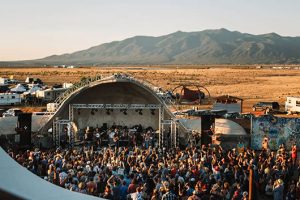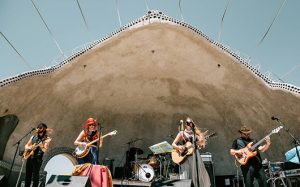
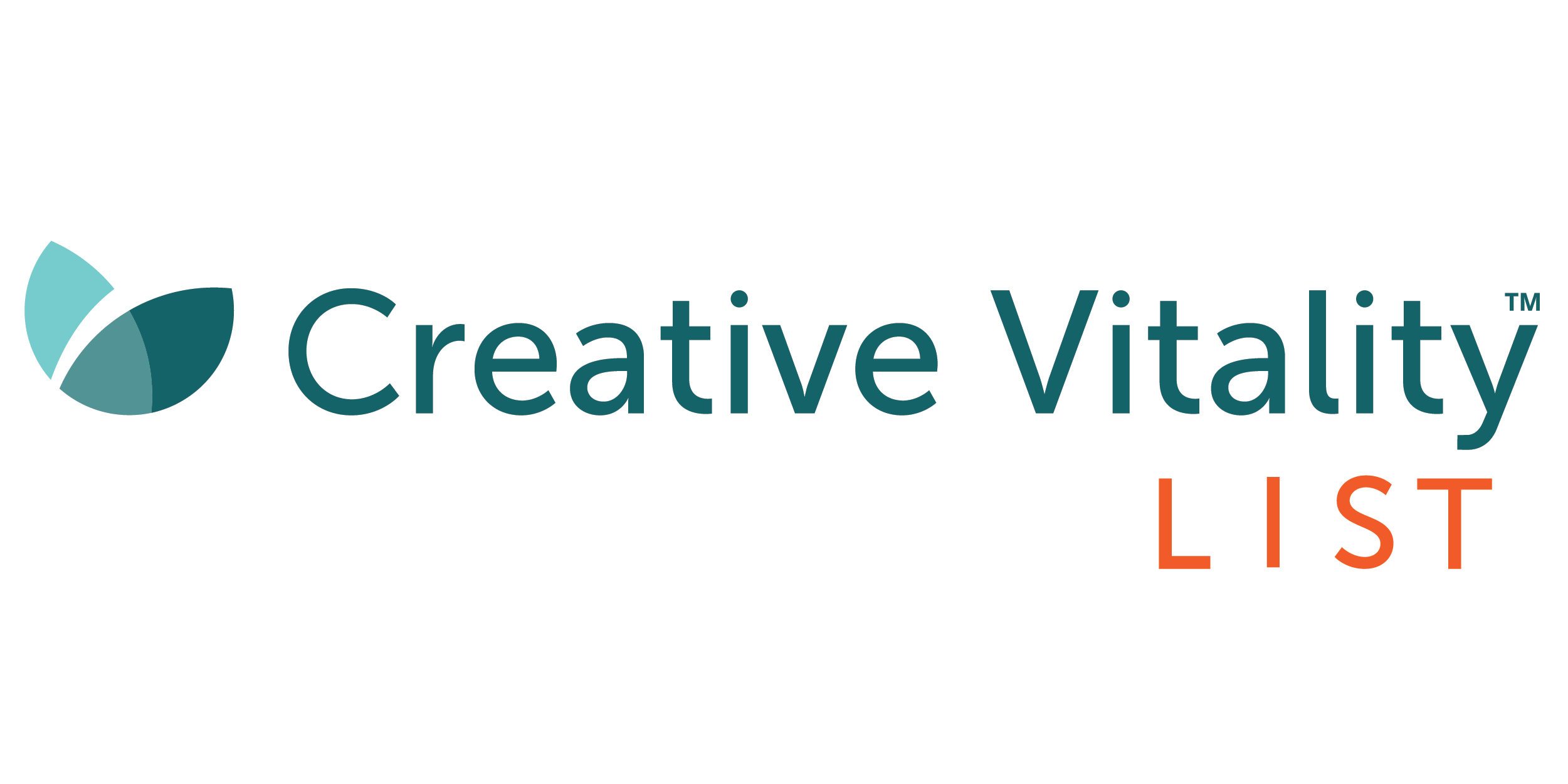
THE TOP 10
MUSIC CITIES YOU
NEED TO KNOW ABOUT
CVSuite™ is excited to present the Creative Vitality List™, a series of data-driven profiles that chronicle the economic impact of arts and culture on the local economy. The next installment of the Creative Vitality List is the Top 10 Music Cities You Need to Know About. In an effort to look beyond well-known creative hotspots like New York, Los Angeles, Nashville, and Austin, this list focuses on music cities with a population of 500,000 or less and aims to showcase the vitality of smaller creative communities that you should know about.
We were delighted to see some cities that were also included in our first list, the Top 30 Most Creative Small Cities, including Pittsfield, Massachusetts; Kingston, New York; and Santa Fe, New Mexico, as well as some newcomers such as Taos, New Mexico and Vineyard Haven, Massachusetts.
Our team of creative economy experts identified 817 core-based statistical areas (CBSA) metropolitan divisions, and combined statistical areas (CSA), as defined by the Census, with populations of less than 500,000. The team analyzed the components of economic and creative vitality in the regions, focusing on the economic contribution of musicians, singers, and related workers. The list was then analyzed from highest to lowest value based on the location quotient, a ratio that was used to compare the concentration of music-related jobs in those locations to that of the United States as a whole. We refer to this measurement as the “music location quotient.”
It comes as no surprise that regions with vibrant creative output in one field also excel in others. In addition to the highly concentrated economic impact of musicians, singers, and other related workers, we found the “Top 10 Music Cities You Need to Know About” (and the runners-up) have impressive economies that feature racial diversity and a telling Creative Vitality Index™ value, indicating impressive concentrations of creative industries and cultural nonprofits, as well as high earnings for creative workers.
This list comes at a time when the creative economy and the music industry in particular are experiencing the devastating impact of COVID-19. In times like these, we believe wholeheartedly in finding inspiration in the small communities that continue to demonstrate their vitality and resiliency time and again. The economic impact of creative industries on these communities is backed by data and communicated by the stories we share.
MUSIC LQ: 1.74
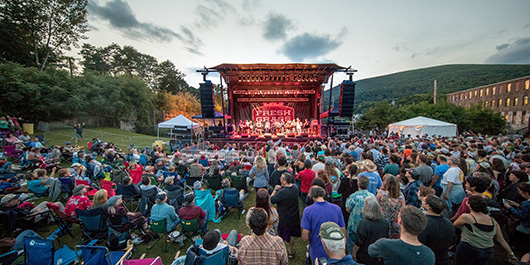
Image by Douglas Mason
Pittsfield, Massachusetts is known as the “City of Festivals.” With a population of 126,349 and perfectly placed in the heart of the Berkshires, this surprising haven bustles with cultural and recreational opportunities. Pittsfield has a music location quotient (LQ) of 1.74, with a total of 451 musicians, singers, and other related workers. This means that Pittsfield has 1.74 times the concentration of musicians and singers when compared to the national average. This community’s overall Creative Vitality Index value is an impressive 2.33. Pittsfield’s creative economy as a whole generated $83.3 million in sales in 2018 and employs 3,291 people.

Image by Stephanie Zollshan
Pittsfield’s downtown, known as the Upstreet Cultural District, boasts a lively roster of music, dance, theater, community festivals, and celebrations. Pittsfield includes the historic neighborhood of Tanglewood, the summer home of the Boston Symphony Orchestra. In recent years, this historic downtown area has seen significant investment and is home to many restaurants and cultural attractions. The city is home to the Barrington Stage Company’s Musical Theater Lab, which is on a quest to make Pittsfield “the epicenter of the musical theater universe.” For more mainstream music fans, Times Union Center and the Palace Theater provide stages for many nationally renowned touring acts. In addition to boosting the city’s creative economy, Pittsfield’s thriving music scene helps shape the character of the community by offering distinct cultural experiences for locals and visitors alike.
MUSIC LQ: 1.75
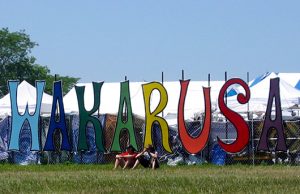
Image by Rich Anderson Photography
Located in northeast Kansas, Lawrence is a multifaceted city that offers big city amenities while still maintaining a strong sense of community. With a population of 121,413, Lawrence has a music location quotient of 1.75 and a total of 382 musicians, singers, and other related workers. This means that Lawrence has 1.75 times the concentration of musicians and singers when compared to the national average. This community’s overall Creative Vitality Index value is a solid .94. Lawrence’s creative economy as a whole generated $18.9 million in sales in 2018 and employs 2,800 people.
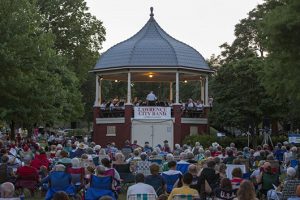
Image by John Young Photography
Most cities don’t have a songbook of all the music created within the city walls, but Lawrence soon will! The Lawrence Songbook will bring together local musicians, artists, and community leaders to create a fully illustrated collection of notated music and lyrics from some of the city’s most prolific musical artists. Lawrence has a reputation for being the “live music capital of Kansas,” thanks to its impressive roster of local performers and long history of performances by well-known musicians like Nirvana, Green Day, George Clinton, and Public Enemy. The Lied Center at the University of Kansas hosts a range of musical acts throughout the year and has previously hosted such luminaries as Kenny Rogers. Originally built in the 1930s as a silent movie theater, the Granada has been hosting live music since 1993. Venues like these, along with a wide selection of local bars featuring live performances, help to keep Lawrence’s reputation as a music city alive and well!
MUSIC LQ: 1.77

Image by All American Country Music Festival
Ruidoso, New Mexico is rich in Native American culture, famous forts, and time-honored traditions. With a population of 19,556, Ruidoso has a music location quotient of 1.77, as well as a total of 57 musicians, singers, and other related workers. This means that Ruidoso has 1.77 times the concentration of musicians and singers when compared to the national average. With a population of 19,556, Ruidoso’s overall Creative Vitality Index value is an impressive 1.03. Ruidoso’s creative economy as a whole generated $7.5 million in sales in 2018 and employs 355 people.
The live music scene in Ruidoso, New Mexico is hotter than ever! In the summer, the city has live music performances almost every weekend, including shows, concerts, and music festivals for every season. Ruidoso’s venues run the gamut, from coffee houses, brewpubs and wine bars, to outdoor festivals like the All American Country Music Festival, a two-day event that features more than 50 food, art and craft vendors. The city also hosts year-round performances at the Spencer Theater for the Performing Arts, the Inn of the Mountain Gods Resort and Casino, and Midtown’s free Music in the Streets series. A landmark in downtown Ruidoso, Win, Place, or Show is a true honky tonk bar and a great place to do some two-stepping into the wee hours, with live country music performances every night.Because of the town’s popularity as a vacation destination, top-name country singers, big-band crooners, and edgy newcomers are happy to make Ruidoso a stop on their tour. Visitors can come for the show, stay for the night, and spend the next day adventuring like a local.
MUSIC LQ: 1.85
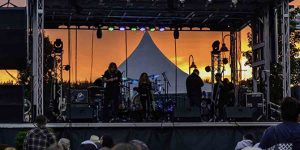
Image by Jack Penland
With a population of 84,46, a music location quotient of 1.85, and a solid Creative Vitality Index value of 0.77, Oak Harbor, Washington is Whidbey Island’s largest incorporated city. Located just two hours north of Seattle and two hours south of the Canadian border, Oak Harbor offers locals and visitors small town ambiance with a generous helping of live music.
Oak Harbor’s vibrant downtown offers a thriving music scene. Every Labor Day weekend, the city plays host to the Oak Harbor Music Festival, which showcases over 30 bands across two main stages. A wide range of musical genres are covered across the weekend, and the best part? Admission is free! Oak Harbor also offers plenty of opportunities to catch live local music performances year-round at small venues like the Wicked Teuton Brewing Company and Rock Island Coffee. Oak Harbor’s wide range of local musicians includes the established hardcore punk band Potbelly, which has released 90 albums since the band was formed in 1995. This is one small town that knows how to rock!
MUSIC LQ: 2.03

Image by Mountain Jam
The first city in the United States, Hudson, New York is a two-hour trip from the city of Manhattan. With a population of 59,922, this small city has a large music location quotient of 2.03, with a total of 209 musicians, singers, and other related workers. This means that Hudson has 2.03 times the concentration of musicians and singers when compared to the national average. Hudson’s overall Creative Vitality Index value is a strong 1.34 and its creative economy as a whole generated $40.5 million in sales in 2018 and employs 1,477 people. This former factory town has grown into a vibrant and thriving city.
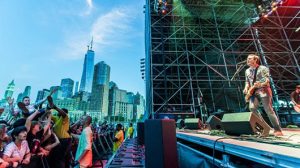
Image by Joe Papeo Photography
Hudson has much to offer art and music lovers. The Hudson Jazz Festival attracts exceptional musicians to the city while providing a great place for music lovers to gather for an incredible weekend of jazz.Hudson’s reputation as a music town got a boost when Club Helinski moved from Massachusetts to make this city its home. In addition to a long list of folk artists, the Magnetic Fields, Frank Black, and Thurston Moore have also performed for Club Helinski audiences. More live entertainment can be found at Hudson Hall, a prominent historic building located in the heart of the city and New York state’s oldest surviving theater.Hudson Hall contributes to the regeneration of downtown Hudson and the surrounding region by providing the community with year-round programming. Hudson Hall remains one of the country’s most renowned venues for artists and musicians. This city’s thriving music scene is perhaps best summed up by the title of Carrie Nieman Culpepper’s 2010 New York Times article, Hudson, NY: Where Bands Feel at Home.
MUSIC LQ: 2.16

Image by Josh Robinson-White
Vineyard Haven, Massachusetts is a small and vibrant arts community located in the town of Tisbury, Massachusetts, which serves as the year-round port for Martha’s Vineyard. With a population of 17,351, Vineyard Haven has a music location quotient of 2.16, with a total of 118 musicians, singers, and other related workers. This means that Vineyard Haven has 2.16 times the concentration of musicians and singers when compared to the national average. This community’s overall Creative Vitality Index value is an impressive 3.65. Vineyard Haven’s creative economy as a whole generated $27.9 million in sales in 2018 and employs 877 people.
Nancy Gardella, executive director of the Martha’s Vineyard Chamber of Commerce, explained that Vineyard Haven, which is home to a diverse designated cultural district, is anchored by the Martha’s Vineyard Museum. The town’s cultural and artistic heritage includes two movie theaters, a professional playhouse, wooden shipbuilding, fashion, literature, visual arts, sculpture, historic architecture, music, galleries, studios, and so much more!
Vineyard Haven also hosts Beach Road Weekend, a three-day outdoor summer music event featuring 40 acts on two stages, which draws thousands of music lovers to the area each year. Weekly bandstand concerts also take place in the beachside gazebo in Ocean Park, and monthly First Friday events along Main Street always include lots of live outdoor musicians. Vineyard Haven has hosted nationally known musicians like James Taylor and Carly Simon, with regional favorites such as Johnny Hoy and the Bluefish, Phil DaRosa, Willy Mason, Livingston Taylor, Beetlebung Steel Band, Sally Taylor, John Alaimo, Mike Benjamin, Jerome Clark, and the Vineyard Sound performing on any given day, adding a distinctive vibrancy to the Island.
MUSIC LQ: 2.26

Image by Brian Lasky Photography
Located in Ulster County New York, Kingston has a population of 178,595 and a music location quotient of 2.26, with a total of 628 musicians, singers, and other related workers. This means that Kingston has 2.26 times the concentration of musicians and singers when compared to the national average. This community’s overall Creative Vitality Index value is an impressive 1.27. Kingston’s creative economy as a whole generated $125.2 million in sales in 2018 and employs 4,083 people. Dating to the arrival of the Dutch in 1652, Kingston is a vibrant city with rich history and architecture. New York’s first capital, Kingston is home to a thriving arts community.
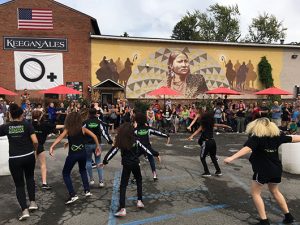
Image by O+ Festival
The city is a musical hub that supports local artists through its Music in the Park events. These concerts are free and open to the public, providing family entertainment and bolstering a sense of local community. Kingston’s Ulster Performing Arts Center is a newly renovated historic theater that holds an audience of 1,500 and offers the city year-round entertainment, including performances by national touring musicians. Listed on the National Register of Historic Places, Ulster Performing Arts Center is one of the last great show palaces in New York State. Another venue making an impact on the city is BPS Kingston, a local performance and gathering space for artists and musicians of all genres. In addition to hosting performances, BPS Kingston also manages dozens of ongoing programs that benefit the community. A tour of the city’s wide array of independent venues reveals performances ranging from beatboxing to rock ‘n’ roll, and it is clear that Kingston plays a vital role in America’s live music scene.
MUSIC LQ: 2.64

Image by Santa Fe Opera
New Mexico’s capital, Santa Fe is renowned for its Pueblo-style architecture and as a creative arts hotbed. With a population of 150,058, Santa Fe has a music location quotient of 2.64, with a total of 772 musicians, singers, and other related workers. This means that Sante Fe has 2.64 times the concentration of musicians and singers when compared to the national average. This community’s overall Creative Vitality Index value is an impressive 2.78. The city’s creative economy as a whole generated $206 million in sales in 2018 and employs 5,386 people. Santa Fe is home to recording studios and record labels where musicians and promoters work together to produce a sound reflective of the city’s cultural landscape.
The city offers something for every music lover, with a wide selection of smaller venues for a more intimate live experience, as well as larger venues like the historic Lensic Performing Arts Center. A recipient of National Endowment for the Arts’ TourWest grants, the Lensic Performing Arts Center is a frequent stop for nationally renowned touring artists. Santa Fe’s vibrant and eclectic live music scene truly has something for everyone, including blues, country, jazz, and everything in between. GiG Performance Space hosts performances by national and regional musicians, in addition to offering educational events and serving as a hub for the local Santa Fe music community. Other local venues include Tiny’s Restaurant and Lounge, a family-owned establishment that has been serving up live entertainment since 1950. The historic La Fiesta Lounge at La Fonda offers its guests the opportunity to see performances by local musicians every night of the week. The city also presents a host of annual music events, including the Santa Fe Chamber Music Festival, Santa Fe Bandstand, and the Santa Fe Opera, which is considered one of the world’s leading cultural festivals. Another venue that attracts national touring musicians to the area is Santa Fe Pro Musica, which brings together outstanding musicians to inspire and educate audiences of all ages through the performance of great music. Performance Santa Fe presents an impressive year-long season of music, dance, and theater in multiple venues across the city. The incredible variety of musical experiences available in Santa Fe help make it the vibrant cultural hub that locals are happy to call home and visitors are excited to come back to.
MUSIC LQ: 2.84
The fact that Taos, New Mexico has a population of just 32,835 makes it all the more impressive that it has earned such a formidable position in the American arts and entertainment scene. Taos has a music location quotient of 2.84, with a total of 155 musicians, singers, and other related workers. This means that Taos has 2.84 times the concentration of musicians and singers when compared to the national average. The city’s reputation as a musical hotbed has helped it achieve a Creative Vitality Index value of 1.16, making it one of the premier live music locations in New Mexico. Taos’ creative economy as a whole generated $18.8 million in sales in 2018 and employs 942 people.
The Taos Center for the Arts draws locally and nationally renowned acts and is home to three chamber music groups. The many opportunities to enjoy live music in Taos include venues like the Adobe Bar (“the living room of Taos”); the Sagebrush Cantina, which has featured performances from artists like Taj Mahal, Abraxas, and Ricky Nelson; and the historic Old Martina’s Hall, a restaurant and dance hall with a long and colorful history of live entertainment. Taos is also home to a wide variety of music events and festivals to delight locals and tourists alike, including Taos Plaza Live, Music in the Park, and Taos Vortex, an immersive weekend of art and music presented by the art collective Meow Wolf. Thanks to plenty of local venues and amazing talent, the Taos music scene keeps its fans happy and coming back for more!
MUSIC LQ: 3.14

Image by SwiftShots
When most people think about Missouri, they probably think of great barbeque, Budweiser, and the St. Louis Cardinals. But nestled in this state is a thriving arts scene, epitomized by the town of Branson. With a population of 55,852, this creative powerhouse boasts a music location quotient of 3.14, with a total of 369 musicians, singers, and other related workers. This means that Branson has an impressive 3.14 times the concentration of musicians and singers when compared to the national average. This is why Branson, Missouri is number one on our list and boasts a Creative Vitality Index value of 2.09. Branson’s creative economy as a whole generated $79.3 million in sales in 2018 and employs 1,606 people.

Image by Meadows Images
Branson has dozens of theaters offering more than 100 live shows with Broadway, country, pop, swing, rock ‘n’ roll, big band, magic, and comedy performances. A trip to Branson is not complete without experiencing Silver Dollar City, an 1880s theme park where you’ll find authentic Ozark history with crafts, eateries, six festivals, and thrilling rides. Ozark Mountain visitors can enjoy three lakes, perfect for fishing and boating, as well as golf, hiking, and horseback riding. Branson has more than 200 outlet stores, an array of specialty stores, boutiques, and galleries at Branson Landing and a Historic Downtown filled with quaint shops.
Live music has been central to Branson’s heritage since the 1960s and the city has attracted millions of visitors each year with its live music shows, family attractions, outdoor recreational activities, and the Ozark Mountains’ natural beauty. Live shows are still cited as Branson’s number one attraction and tourism driver by its visitors. Check out www.ExploreBranson.com for more information on this vibrant music city!
To build our top 10 small music cities list, our data engineers took the 926 core-based statistical areas (CBSA), metropolitan divisions, and combined statistical areas (CSA), as defined by the Census, and then pared them down to the 817 areas with populations of less than 500,000.
We then arranged the remaining regions from highest to lowest value based on concentration of Standard Occupational Classification (SOC) code 27-2040 jobs (musicians, singers, and related workers), as compared to the U.S. This ratio is known as a location quotient (LQ).
The Concentration of Musicians by CBSA map geographically visualizes the full list of CBSAs with populations of less than 500,000. The map shows each region’s concentration of musicians, singers, and related workers as represented by their location quotient.
Location quotient is determined by approximate concentration of job counts for the SOC code 27-2040 within the CBSA as compared to the national average. Musicians, singers, and related workers’ job counts are built using the Bureau of Labor Statistics’ (BLS) Quarterly Census of Employment and Wages (QCEW) industries data set in combination with the national Occupational Employment Statistics (OES) staffing patterns. Each CBSA is then ranked by concentration of musicians, singers, and related workers from highest to lowest.
While we are excited to showcase the vibrancy of the places that make up our Top 10 List, small communities across the United States have competitive economic data that demonstrate the vibrancy of their musical and creative communities. Check out numbers 11 through 30 and more!
The Concentration of Musicians by CBSA map also displays the approximate racial/ethnic representation of musicians, singers, and related workers within each CBSA. This demographic data is built using the Census’ Quarterly Workforce Indicators (QWI) data supplemented with American Community Survey data. People of Color (POC) are defined as non-white workers. A more detailed breakdown of the demographics can be found in the Ethnic/Racial Representation of Musicians, Singers, and Related Workers chart.

